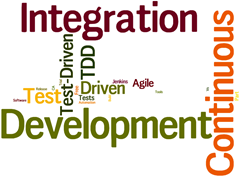
One problem we often have when performing application test is that if we are testing applications that modify the database in some way, we can’t test without modifying the database.
In an ideal world, one way you could deal with this issue is to create a test database that has known data. But even then, you have to go through the effort of setting up the data prior to each test.
To be clear, I’m not talking about unit test. You should have unit test for most of your code. I’ll handle what not to test in some other post. But, at some point you will want to put together a suite of test that ensures that the application, as a whole, does what you expect it to do.
So, the stated problem is this, “How do we test a web application in such a way that we are always working with known data and in such a way that we do not ever modify the data in the database?”
So far, I’ve not found a way that test the whole web application from the user interface down to the database. But, I think I’ve found the next best thing. Split the application in half between the view and the database and perform two, overlapping, integration test. If both work, we can reasonably assume that the whole application works.
So how would we go about doing this?
If you’ve designed your application correctly, you should have a seam somewhere in the center. In my code it tends to either be at the business logic layer or at the data access layer. What we want to do is to create a separate class, or set of classes that look just like the classes at that layer and swap them in while testing the top half of our application and use the real classes when testing the bottom half of the application and when using the application in production.
We do this using dependency injection using your favorite dependency injection framework. I’m not going to go into the details of dependency injection here. Maybe some other day. But this is a place where you would use it.
Test the top half
In the fake DAL or BLL classes, what you are going to do is return what amounts to hard coded values. In a recent implementation, I stored the JSON representation of the values in a resource (RESX) file using the parameters that were passed into the method call as keys so that I could retrieve that data. If you need to do an update, you will need to store that some place so that your test code can verify that it got passed down to the function that should have saved it to the database.
By doing this, you can verify that your code from the presentation layer down to this seam works as it should. Now we need to test the bottom half of our code.
Test the bottom half
This will be a bit easier. What we do here is we have our test code run the code directly. But, unlike when we run the code in production, we will wrap the code in transaction tracking starting with our setup method. We turn on transaction tracking, get the database into the state that we need for testing, run our test, and then rollback the changes. Assuming the transaction tracking works correctly, and we have to assume that our third party tools do, this test everything without modifying the database.
Because we’ve tested both the top half of the code and the bottom half of the code, we now have a reasonable assurance that the code as a whole works as it should.
 Today I thought I’d talk to you about the programming principle known as DRY. As you may know, DRY stands for “Don’t Repeat Yourself” and it shows up in a lot more places than you might expect. Even when you try really, really hard to not repeat yourself, you end up repeating yourself. You repeat yourself even when you think you aren’t. Lots of people repeat themselves. Do you know of any? Ok. I think you get the point. Just like it is silly for me to repeat myself over and over again, it is silly for you to write the same code, or perform the same steps, over and over again.
Today I thought I’d talk to you about the programming principle known as DRY. As you may know, DRY stands for “Don’t Repeat Yourself” and it shows up in a lot more places than you might expect. Even when you try really, really hard to not repeat yourself, you end up repeating yourself. You repeat yourself even when you think you aren’t. Lots of people repeat themselves. Do you know of any? Ok. I think you get the point. Just like it is silly for me to repeat myself over and over again, it is silly for you to write the same code, or perform the same steps, over and over again. I recently had an experience writing code that proved to me, once again, that using Test Driven Development really is faster than the way I have been working. You will remember a couple of weeks ago I presented
I recently had an experience writing code that proved to me, once again, that using Test Driven Development really is faster than the way I have been working. You will remember a couple of weeks ago I presented  I used to ignore warnings when I compiled my code. Most of the time they never caused any problems and I was able to run my code. But recently I’ve gotten pickier about my code. One area I’ve gotten more picky about is compiler warnings.
I used to ignore warnings when I compiled my code. Most of the time they never caused any problems and I was able to run my code. But recently I’ve gotten pickier about my code. One area I’ve gotten more picky about is compiler warnings. With all this talk of test driven development, one has to naturally ask, “Where does the QA department fit in? Do they even have a role in the organization any more?” Well, the answer to that is, “absolutely but probably not the role they think they have.”
With all this talk of test driven development, one has to naturally ask, “Where does the QA department fit in? Do they even have a role in the organization any more?” Well, the answer to that is, “absolutely but probably not the role they think they have.” First, at the suggestion of one of my friends who now works at
First, at the suggestion of one of my friends who now works at  So far we’ve been talking about creating test as part of the development process. If all you ever used those test for was to make the design of your systems better, you would already be far ahead of most of your peers.
So far we’ve been talking about creating test as part of the development process. If all you ever used those test for was to make the design of your systems better, you would already be far ahead of most of your peers.

 While the artifact of Test Driven Development is test code, what you get out of test driven development far exceeds the test themselves.
While the artifact of Test Driven Development is test code, what you get out of test driven development far exceeds the test themselves. 